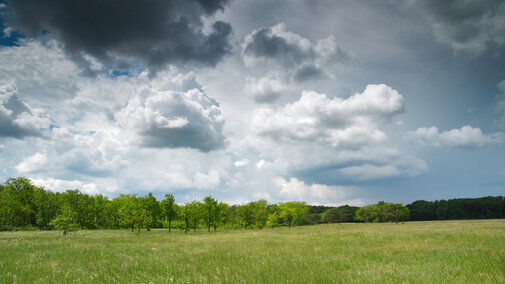Reducing Rain Damage to Hay
Harvesting high quality hay between rain and storm events can be a challenge. So, how do you best manage this risk?
Legumes like alfalfa are more impacted by rainfall than grass forages, especially if leaves are shattered or dropped from extra windrow raking or turning. Quality losses are minimal if the rain occurs soon after plants are cut off before the curing (drying) process begins.
Heavy (one inch-plus) rains typically leach 10% of the soluble sugar nutrients out of the hay, and losses can increase to over 30% if multiple rain events occur during curing. Typically, losses are usually from 5-15% with each additional rain.
To minimize rain damage, producers focus on limiting field exposure time after the forage is cut. Practices such as spreading windrows as wide as possible, chemical or mechanical conditioning, and timely raking can speed forage dry-down from two days to one-half day.
Another effective strategy is harvesting at higher moisture content. Chopping alfalfa for silage is a way to limit weather risks. A newer technique is to wrap high-moisture alfalfa as bale silage. All silage harvesting methods can move alfalfa off fields in two days or less.
A final strategy is to use protectants to bale alfalfa at a slightly higher than normal moisture content. Hay inoculant preservatives like propionic acid and acetic acid reduce mold formation and potential heat damage of baled alfalfa. These forage additives work well if the forage is just slightly wetter than normal and applied correctly under certain harvest conditions and can save as much as a full day of drying time.
Hail in Pasture and Hay
Row crops often get priority attention when a hailstorm rolls through, but bad storms can do a number on perennial forages as well. When hail strikes your pasture or hay field, do you know what to do?
Timing of hail is probably the most important factor when assessing hail impacts on forage crops. Because our perennial forage crops are resilient — they do put up with regular grazing or haying after all — the real danger of a hail event is lost yield.
In pastures where standing forage may now be lying on the ground, it’s a good idea to move animals from the affected pasture to allow plants to recover. If regrowth does occur, graze appropriately so overuse doesn’t occur. When dry conditions and hail intersect, regrowth may not happen and returning animals to the pasture may not be an option until moisture returns.
In alfalfa fields, the amount of damage inflicted and timing are key. The University of Wisconsin recommends management by assessing damage based on plant stages of development. Fields with over two weeks to go before harvest can often be left alone and harvested normally, with some yield loss expected. If damage of terminal buds is over 50%, management should instead focus on harvesting regrowth appropriately.
Stands with less than two weeks to go until planned harvest can be harvested normally, with expected yield loss. For those with severe lodging, wait three to four days for plants to right themselves. Disk mowers are better at picking up a lodged crop than sickle bars, but for both, tilt the bar or disc forward to increase forage pickup. If stand damage is severe enough that expected yield does not justify harvesting, management should focus on the harvest of regrowth.
Hailstorms are an unavoidable part of living on the Plains. When a storm impacts your forage production, assessing damage and adjusting management appropriately can help make the best of an unfortunate situation.
Windrow Disease in Alfalfa
By Brad Schick
Alfalfa harvest rarely goes according to plan. Rain, hail, insects, disease and drought all have major effects on the hay, especially once windrowed.
When baling is delayed after cutting or windrowing, the alfalfa field can develop strips of light green or yellow. This occurs because of the lack of sunlight and increased moisture trapped that can create ideal conditions for unwanted diseases. This stresses the alfalfa, resulting in delayed growth and weeds often can invade, prompting the need for spraying. The field growth becomes uneven, creating a varied maturity of alfalfa for the next cutting. So, what part of the field needs to be looked at to determine the next cutting time?
The health of the stand is one consideration while the use or purpose of the hay is the other. If the stand is already thin or experiencing many other stressors, then waiting a little longer to cut may be the better option. If the stand is strong and vigorous, cutting the stressed areas earlier will be fine.
If the purpose of the hay is high quality hay such as for dairies, the earlier cutting needs to be done, but if hay is for beef cattle, let the stunted plants have a chance to grow longer before the next cutting.
Delayed baling will always happen — making a solid management decision for the next cutting will keep the alfalfa strong and the hay useful.

